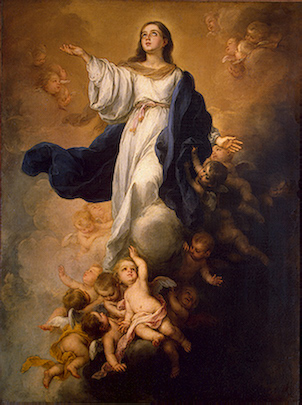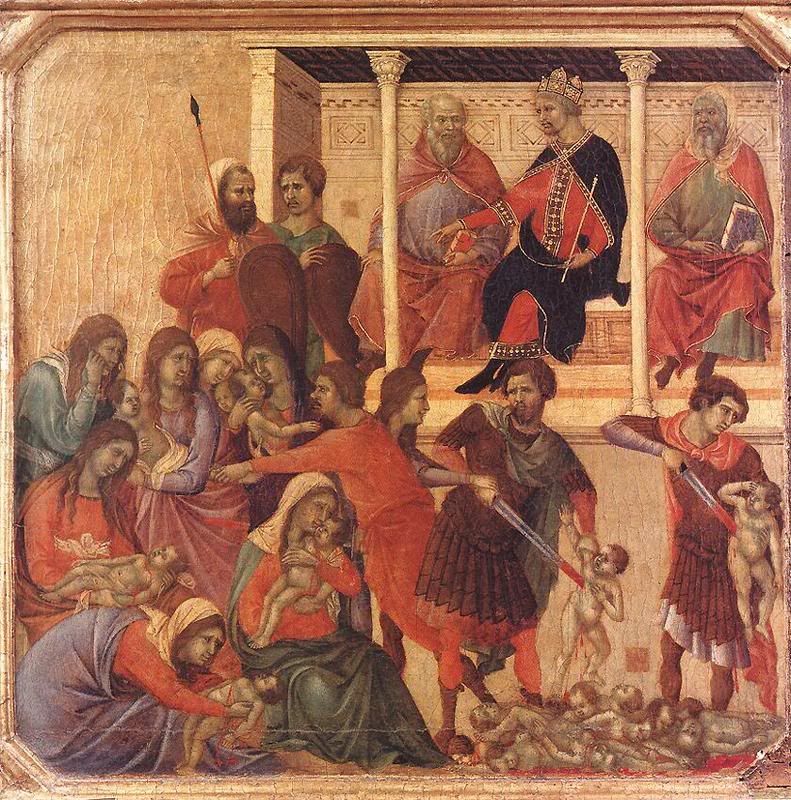
The Immaculate Conception, by Bartolomé Esteban Murillo, taken from Hermitage : The Masterpiece 2[The following is excerpted from
A First Milestone in the Rise of the Counter-Revolution, by Plinio Corrêa de Oliveira. As the American TFP explained before
another article by this author, "he uses the words 'Revolution' and 'Counter-Revolution' as he defined them in his book Revolution and Counter-Revolution. In this sense, the Revolution is a centuries-old process, motivated by pride and sensuality, and therefore egalitarianism and liberalism, that dominates the modern world and seeks to destroy Christian civilization."]
"Pope Pius IX’s definition of the dogma of the Immaculate Conception had varied but profound repercussions from all over the civilized world."
"It caused great enthusiasm in the faithful at large. They delighted in seeing a Vicar of Jesus Christ proclaim this dogma using the fullness and majesty of his power. It was an admirably gallant and bold challenge to the triumphant skepticism already gnawing at the entrails of Western civilization."
"They delighted yet more by the fact that it was a Marian dogma. This attacked liberalism which by its very nature gave rise to yet another nineteenth century scourge – interconfessionalism. This scourge highlights everything religions have in common (usually a vague deism) and underrates, if not outright rejects, everything that separates them. Thus, the open or secret interconfessionalists of 1854 saw this proclamation of a new Marian dogma (like the definition of the Assumption much later) as a serious and unexpected barrier towards achieving their goals."
"The new dogma also deeply shocked the essentially egalitarian mentality of the French Revolution, which since 1789 had despotically held sway in the West. To see a mere creature elevated so far above all others, enjoying an inestimable privilege from the very first instance of her conception is something that could not and cannot fail to hurt the children of a Revolution which proclaimed absolute equality among men as the basis of all order, justice and goodness. It was painful for both non-Catholics and Catholics, more or less infected with this spirit, to accept the fact that God established in creation and highlighted such outstanding inequality."
"Finally, liberals dislike the nature of that privilege as such. Indeed, anyone who admits the existence of Original Sin, with all the spiritual disorders and miseries of the body that it entails, must accept that man needs an authority that he must obey. The definition of the Immaculate Conception was an implicit reaffirmation of Church teaching in this matter."
"However important all these points may be, there is yet another that we would dare call the very 'salt' of the dogma's glorious definition. It is impossible to think about the Immaculate Virgin Mary without recalling how she triumphantly and definitively crushed the serpent’s head under her heel. The Revolutionary mentality is the mentality of the devil himself. A person of faith cannot fail to recognize the role the devil has played in the rise and propagation of the errors of the Revolution, from the religious disasters of the sixteenth century to the political debacle of the eighteenth century and all that followed."
"For the devil to see such a triumphal affirmation of his longstanding and inflexible enemy was his most horrible humiliation. Hence, the proclamation must have given rise to an uproar of human voices and satanic howls like an immense and thunderous storm all over the world. For true Catholics, watching the intrepid and majestic figure of the Vicar of Christ standing alone against that tempest of unruly passions, threatening hatreds and furious despair, armed only with heavenly assistance, caused a jubilation like the one the Apostles felt during the storm on the Sea of Genesareth when the Savior commanded the winds and the sea to be calm: '
venti et mare oboediunt ei' (Mt. 8:27)...."

[Statue of Our Lady of Lourdes, at the very spot she appeared to St. Bernadette Soubirous in 1858, taken from Lourdes Gallery]"At the time of Lourdes [in 1858], Catholic circles in Europe and the Americas had long suffered from a real religious leprosy, Jansenism. This heresy sought to weaken the Church by undermining devotion to the Holy Eucharist under the pretext of a false respect. Its proponents imposed so many conditions for a person to go to Communion that unfortunately a large number of people under its influence practically stopped receiving Our Lord. On the other hand, Jansenists carried out a relentless campaign against devotion to Our Lady, which they said deviated people from Jesus Christ rather than leading them to Him. Finally, the heresy promoted an incessant campaign against the Papacy and especially papal infallibility."
"The definition of the dogma of the Immaculate Conception was the first of the great setbacks suffered by this internal enemy. Indeed, it gave rise to a huge wave of Marian piety, which has been increasingly growing."
"To prove that everything comes to us through Mary, Divine Providence willed that its first great triumph be Our Lady’s triumph...."
"One could ask: what effect did Lourdes, the dogma proclamations and these other victories have on the struggle of the Church against her external adversaries? It would seem that the enemy is stronger than ever and that we are drawing near the era envisaged by Enlightenment thinkers centuries ago. This would be a time of crude scientific naturalism dominated by materialist technology and a one-world government with a more or less philanthropic and humanitarian orientation sweeping the last vestiges of supernatural religion from earth. Who can deny that there is not a dangerous slide of Western society toward the realization of this 'ideal' today?"
"This slide is even closer than most people believe. However, no one seems to notice a development of primordial importance. While the world is being fashioned to fit this sinister design, it is also experiencing a profound, immense and indescribable uneasiness."
"This uneasiness is an unconscious and vague malaise that remains undefined even in those aware of it. However, few would contest the reality of this discontent. One would say all humanity is suffering from a kind of violence against its nature. In response, all its wholesome fibers twist and turn as they resist. There is a longing for something else, which people still cannot define. Perhaps for the first time since the decline of Christian civilization beginning in the fifteenth century, the whole world moans in darkness and pain like the prodigal son when he reached the last degree of shame and misery away from his father’s house. At the very moment when iniquity seems to triumph, that victory seems flawed and frustrated."
"Experience shows this kind of discontent often gives rise to the great surprises of history. As the twisting and turning increases, so does discontent. It is hard to tell what magnificent reactions can appear."
"The hour of Divine mercy for a sinner often comes amid extreme sin and sorrow..."
"From our perspective, we might conclude that this promising uneasiness could well be the fruit of a resurrection of Catholic souls worked through the great events mentioned above. This resurrection has the capacity to reinvigorate all the remnants of life and sanity in all cultural areas of the world...."










